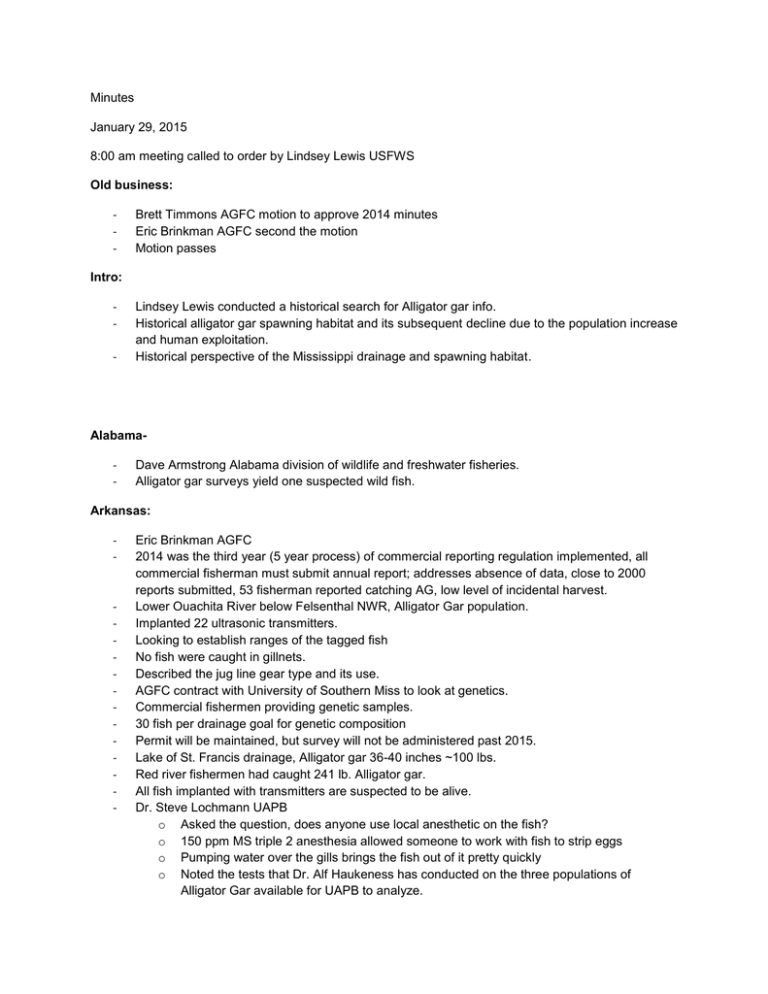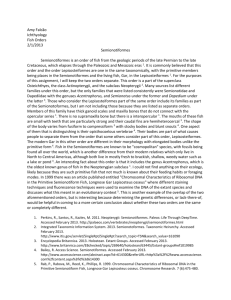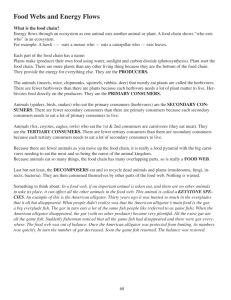Click Here
advertisement

Minutes January 29, 2015 8:00 am meeting called to order by Lindsey Lewis USFWS Old business: - Brett Timmons AGFC motion to approve 2014 minutes Eric Brinkman AGFC second the motion Motion passes Intro: - Lindsey Lewis conducted a historical search for Alligator gar info. Historical alligator gar spawning habitat and its subsequent decline due to the population increase and human exploitation. Historical perspective of the Mississippi drainage and spawning habitat. Alabama- Dave Armstrong Alabama division of wildlife and freshwater fisheries. Alligator gar surveys yield one suspected wild fish. Arkansas: - - Eric Brinkman AGFC 2014 was the third year (5 year process) of commercial reporting regulation implemented, all commercial fisherman must submit annual report; addresses absence of data, close to 2000 reports submitted, 53 fisherman reported catching AG, low level of incidental harvest. Lower Ouachita River below Felsenthal NWR, Alligator Gar population. Implanted 22 ultrasonic transmitters. Looking to establish ranges of the tagged fish No fish were caught in gillnets. Described the jug line gear type and its use. AGFC contract with University of Southern Miss to look at genetics. Commercial fishermen providing genetic samples. 30 fish per drainage goal for genetic composition Permit will be maintained, but survey will not be administered past 2015. Lake of St. Francis drainage, Alligator gar 36-40 inches ~100 lbs. Red river fishermen had caught 241 lb. Alligator gar. All fish implanted with transmitters are suspected to be alive. Dr. Steve Lochmann UAPB o Asked the question, does anyone use local anesthetic on the fish? o 150 ppm MS triple 2 anesthesia allowed someone to work with fish to strip eggs o Pumping water over the gills brings the fish out of it pretty quickly o Noted the tests that Dr. Alf Haukeness has conducted on the three populations of Alligator Gar available for UAPB to analyze. - Use of Anesthetic and the possibility of looking at the stress impact on the fish Looking at blood samples collected during the time of implantation and capture. Determining what the effects of stress are on the fish, with the help of a fish physiologist. Showed photographs from Arkansas ultrasonic transmitter implantation. Vemco brand transmitters. New tag that does data logging via Bluetooth. Battery life of Vr2 receivers discussed. USFWS & UCA o Relocation and capture efforts for tagged Fourche River Alligator Gar. o No spawn detected on the Fourche in 2014. o Genetic from spring spawning sent to Krizer. o White River fishing success was low. o Lower Arkansas. Commercial fishermen saying they’re stacking below Dam 2 in late summer and fall. o Couple of years ago EPA funded study across the Delta. o Reported samples and small populations, reported as Alligator Gar, but were shortnose. o EPA database will forever have false data. o Looking at genetic work to identify the Fourche population. Florida: - Alligator Gar harvest currently closed. Research to reevaluate closer initiated in 2010. Telemetry on the Escambia River to determine movement and habitat use. Mark-recapture population estimate March-June 2014. o High water, near flood stage > 50 % of sampling days. High water made fishing difficult. Co-operative fishing effort helped to improve the skills of all involved. Began to develop some strategies to address and identify spawning habitat. Used double mark hall print tags, which will be helpful in 2015 population estimate. Weedbullit double implant data logger for temp and depth. Addressed the use of Social Media and its positive impact in Florida. Illinois- Did not request or receive fry for reintroduction. Fish kill did claim 3 alligator gar. Northern Illinois winter fish kills, highest since 77-78. o Will be considered for future stocking studies. Future sampling of Alligator Gar populations on Powerton Lake. Kentucky: - Alligator Gar re-introduction efforts. Dietary Comparison of the Gar Community within Clarks River Undergraduate research, gar species identifiers using morphometric analysis. Multivariate analyses to be able to discriminate between gar species based on specific and definitive characteristics that can be identified by John Q Public. Possible to implement this system into fishing guidebooks to aid fishermen in identifying fishes accurately. Looking at adding large amounts of data to the model. Louisiana: - Alligator Gar production at Natchitoches NFH in 2014. Produced fish large enough for implanting coded wire tags. Working on thesis for Rockefeller fish, looking at liver metabolism. Dave Cog & Dave Baums SDAFS Excom Committee members - Inquiring about Alligator Gar Tech Committee. Spoke about banking and the issues surrounding the technical committee. Made it known that Excom will help with any future account switches. Mississippi- No update available. Missouri- Received 900 fish, 842 were stocked in bootheel in various rivers. Study looking at prey selectivity. Proposed regulation change to include AG as state endangered fish – still ongoing. Also using side scan sonar for abundance surveys. Hosting bow fishing clinic emphasizing importance of AG and ethical bow fishing practices. 5000 fry received and 842 fish stocked from those. Oklahoma- Kerry Graves unavailable, update covered by Missouri. They received 5,000 fry for stocking. 70% trained to feed, 40% survival. There was a break-in and some fish were stolen, contributing to mortality. 11.7 inches was the average tl. Stocked fish at 2 fish/ha. - - Stocked 842 fish in St. Francis and Mingo drainages and other canals. Captured a 2007 stocked fish in 2012 that was 57 inches and ~ 60 pounds. Came up with size at stocking and stocking density: stocked large individuals first for telemetry. The 5000 fish from Tishomingo could not be stocked, held them over. Management plan changed to stock 2 fish/acre. Asked the question of other states about stocking rates: what is the reason to raise fish raise fish to 12 inches? Lindsey Lewis seems to think that if you can get fish to 12 inches, they may be able to get on the fast track to growth. Discusses the idea of sharing GPS data about stocking events between states to increase knowledge base. Talked about standardizing the methods and procedures about tag placement for Alligator Gar. Conservation planning document that will be all inclusive to standardize methods and procedures. Possibly use a Google Drive account to share data about methods and procedures. This process will require appointment of responsibilities and increase the precision of data acquisition. Re-emphasized the need for at least a standardized data sheet for sharing on the Google Drive. Possibility of conducting literature review of tagging methods and procedures. Tennessee: No Update Available Texas: - Noted ‘seek and destroy’ method of setting gill nets, and spoke of experimental gill nets. Exploring exploitation of tagged fish in Choke canyon, and the Brazos River. Texas presumes angler exploitation ~ 2%, 2-4% in the Trinity River Any exploitation under 5% should produce a sustainable fishery, even under trophy status. Get a handle on reproduction, have a conceptual model of what they believe the spawn should look like. Work in the Middle Trinity above Livingston, all work associated with tributaries. o - Have attempted to find YOY in the Trinity with visual dip nets, and mini-fyke nets. Never got a flood condition. o Have been able to catch juvenile gar, ~ 200-300 juvenile gars, but mostly spotted gar. o Possible 2-3 juvenile Alligator Gar. Also looking at historical otolith collections, and the production of those year classes in relation to the hydrology that was experienced in those years. Trying to get a better handle on the influences of Alligator Gar year classes. Have agreed that the high water does relate to YOY production. The relationship between water levels and YOY production Looked at flood pulse duration, >= 5 days. Just being above flood stage may not be the predictive variable of a spawn, the specific habitat the adults are seeking may not be inundated in all high water situations. Influence of minimums and maximums of flood stage may be complicated, say 20 feet of water may be negative while 2-6 feet of water may be optimal. Telemetry study may have predicted site fidelity, with some variation (lower Trinity River) Now looking at what proportion of fish are moving from freshwater to saltwater, by pulling otoliths and looking at micro-chemistry. o Got ~ 50 fish to look at Strontium/Calcium chemistry to determine when fish were in each habitat. Looking for someone to do work in the lower Guadalupe to give some stage specific modeling of the fishes. Have been working on seeing if the Gar permit used in Arkansas would work in Texas. o Did a survey of people who would fish for Alligator Gar, and found ~ 100,000 people replied that “they had fished for Alligator Gar”. (Eric Brinkman reports Arkansas at 2% harvest with 300 permits issued). Student at Texas Tech looking at fish recruitment in upper Texoma in the Ouachita and Red River backwater area, caught several larval gar, but were not able to determine if they were Alligator Gar or not, appears that below 2 – 2-1/2 inches the fish are difficult to identify. The fish corresponded to small flood pulses. Be sure to preserve larval fishes in alcohol not the XL fixative. - Break for lunch 11:45-130 - Texas regulations movement o Commissioners worried about protecting spawning habitat and fish, which escalated to a statewide movement, to protect the fish under certain flood conditions, the executive director has the ability to close fishing for alligator gar in any area, on a time specific basis, based on whether or not there is a flood. A moderate flood within any basin with Alligator Gar. o Political issue on Falcon Lake where people thought Alligator Gar were eating LMB. Regulation specific to Falcon Lake where a 5 fish per day limit was implemented. Diet study suggested 1-5% LMB consumed by Alligator Gar per day. Made sure that there was a sunset clause set for 5 years for revision. The population in Falcon seems to be dominated by young fish, 04, 07, and 2010 year classes make up 90% of the fishery. LCC funding on the lower Trinity, will be doing more Lower Trinity work with habitat. Adapting and modifying age estimation for Alligator Gar, have known age OTC marked fish. o Subsampled fish and held indoors for marking to try to induce checks. o Have confidence in age validation. - - - - - - - - o Slightly refined their technique. o Recommended 2 readers and 2 independent estimates. o Trying to come up with minor modifications to correct for mistakes. o There is a significant amount of error that can result from grinding incorrectly. Alan Edwards- Warm Springs National Fish Hatchery. o Alligator Gar and the culture of the fish. o Overfishing thought to be the primary cause of decline. o Culture has been problematic due to cannibalism. o Tried to determine ideal feeding frequency o Tested hypothesis of increased feeding decreases cannibalism. o Controlled temperature of culture areas. o Measured water quality daily and controlled water hardness. o Recorded mortalities daily. o Increased temp with age. o Fish fed 4 times daily, feed size increased daily. o Fish feed Otohomie at arrival after being moved to new area. o Fed fish live food to transition them off of formulated feed. o Growth rate recorded as exponential. o Histogram of mortality showed decline through time, with spike in mortality from moving. o Compared mortality and water temp, increasing temperature leads to decreasing mortality. o Compared Warm Spring’s fish to Natchitoches National Fish hatchery and two more. o Cold snap was primary explanatory mortality variable. o Cannibalism reported experience by Warm Springs fish = 11% New Business o Possible ways to increase involvement in technical committee meetings. o Possibility of selling Alligator Gar t-shirts through AFS website to buy before the meeting. Alligator Gar Technical Committee Co-Chair Vote. o Matt Wagner elected Co-Chair of Alligator Gar Technical Committee. Matt Wagner: o Would like to address making a comprehensive data sheet for Alligator Gar, which would be available through Google Drive to the committee. o Genetic data from Krizer has been put on hold, will be coming along soon. Lindsey Lewis motion to adjourn Motion second Motion passes.




